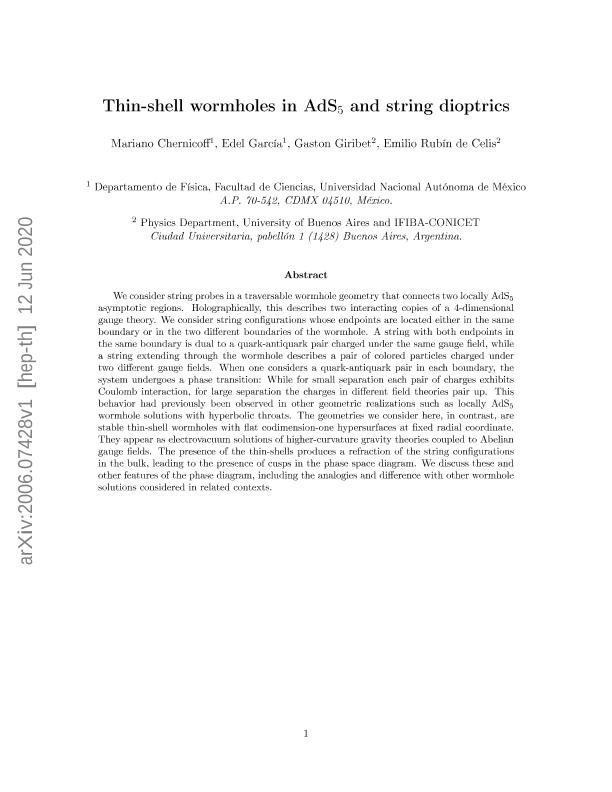Mostrar el registro sencillo del ítem
dc.contributor.author
Chernicoff, Mariano
dc.contributor.author
García, Edel
dc.contributor.author
Giribet, Gaston Enrique

dc.contributor.author
Rubín de Celis, Emilio

dc.date.available
2021-11-05T12:42:58Z
dc.date.issued
2020-10
dc.identifier.citation
Chernicoff, Mariano; García, Edel; Giribet, Gaston Enrique; Rubín de Celis, Emilio; Thin-shell wormholes in AdS5 and string dioptrics; Springer; Journal of High Energy Physics; 2020; 10; 10-2020; 1-24
dc.identifier.issn
1029-8479
dc.identifier.uri
http://hdl.handle.net/11336/146099
dc.description.abstract
We consider string probes in a traversable wormhole geometry that connects two locally AdS5 asymptotic regions. Holographically, this describes two interacting copies of a 4-dimensional gauge theory. We consider string configurations whose endpoints are located either in the same boundary or in the two different boundaries of the wormhole. A string with both endpoints in the same boundary is dual to a quark-antiquark pair charged under the same gauge field, while a string extending through the wormhole describes a pair of colored particles charged under two different gauge fields. When one considers a quark-antiquark pair in each boundary, the system undergoes a phase transition: while for small separation each pair of charges exhibits Coulomb interaction, for large separation the charges in different field theories pair up. This behavior had previously been observed in other geometric realizations such as locally AdS5 wormhole solutions with hyperbolic throats. The geometries we consider here, in contrast, are stable thin-shell wormholes with flat codimension-one hypersurfaces at fixed radial coordinate. They appear as electrovacuum solutions of higher-curvature gravity theories coupled to Abelian gauge fields. The presence of the thin-shells produces a refraction of the string configurations in the bulk, leading to the presence of cusps in the phase space diagram. We discuss these and other features of the phase diagram, including the analogies and difference with other wormhole solutions considered in related contexts.
dc.format
application/pdf
dc.language.iso
eng
dc.publisher
Springer

dc.rights
info:eu-repo/semantics/openAccess
dc.rights.uri
https://creativecommons.org/licenses/by/2.5/ar/
dc.subject
ADS-CFT CORRESPONDENCE
dc.subject
CHERN-SIMONS THEORIES
dc.subject
GAUGE-GRAVITY CORRESPONDENCE
dc.subject.classification
Física de Partículas y Campos

dc.subject.classification
Ciencias Físicas

dc.subject.classification
CIENCIAS NATURALES Y EXACTAS

dc.title
Thin-shell wormholes in AdS5 and string dioptrics
dc.type
info:eu-repo/semantics/article
dc.type
info:ar-repo/semantics/artículo
dc.type
info:eu-repo/semantics/publishedVersion
dc.date.updated
2021-09-07T18:22:30Z
dc.journal.volume
2020
dc.journal.number
10
dc.journal.pagination
1-24
dc.journal.pais
Alemania

dc.description.fil
Fil: Chernicoff, Mariano. Universidad Nacional Autónoma de México; México
dc.description.fil
Fil: García, Edel. Universidad Nacional Autónoma de México; México
dc.description.fil
Fil: Giribet, Gaston Enrique. Consejo Nacional de Investigaciones Científicas y Técnicas. Oficina de Coordinación Administrativa Ciudad Universitaria. Instituto de Física de Buenos Aires. Universidad de Buenos Aires. Facultad de Ciencias Exactas y Naturales. Instituto de Física de Buenos Aires; Argentina
dc.description.fil
Fil: Rubín de Celis, Emilio. Consejo Nacional de Investigaciones Científicas y Técnicas. Oficina de Coordinación Administrativa Ciudad Universitaria. Instituto de Física de Buenos Aires. Universidad de Buenos Aires. Facultad de Ciencias Exactas y Naturales. Instituto de Física de Buenos Aires; Argentina
dc.journal.title
Journal of High Energy Physics

dc.relation.alternativeid
info:eu-repo/semantics/altIdentifier/doi/http://dx.doi.org/10.1007/JHEP10(2020)019
Archivos asociados
